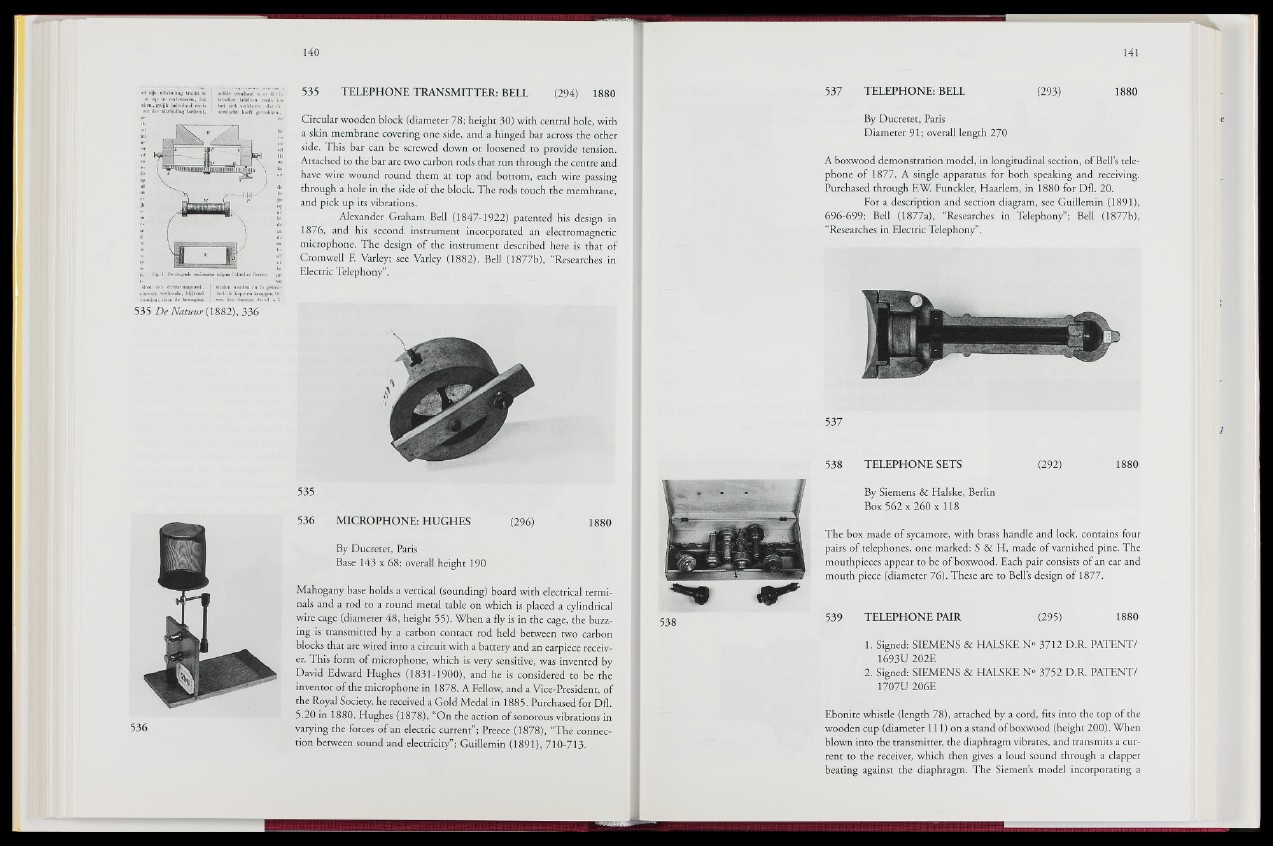
un, goljjk ìiiiloriliiml ri
ir ilor nltvlmling fonico mlnolit Iiòiìfi (totmkki'i
iteli con plektromagnret. | oiudou worden mi in
.■’invorlc Wòvkctuiu, bljjroml I met do kaporcn knof
535 De Natuur (1882), 336
535 TELEPHONE TRANSMITTER: RET T (294) 1880
Circular wooden block (diameter 78; height 30) with central hole, with
a skin membrane covering one side, and a hinged bar across the other
side. This bar can be screwed down or loosened to provide tension.
Attached to the bar are two carbon rods that run through the centre and
have wire wound round them at top and bottom, each wire passing
through a hole in the side of the block. The rods touch the membrane,
and pick up its vibrations.
Alexander Graham Bell (1847-1922) patented his design in
1876, and his second instrument incorporated an electromagnetic
microphone. The design of the instrument described here is that of
Cromwell E Varley; see Varley (1882). Bell (1877b), “Researches in
Electric Telephony”.
535
536 MICROPHONE: HUGHES (296) 1880
By Ducretet, Paris
Base 143 x 68; overall height 190
Mahogany base holds a vertical (sounding) board with electrical terminals
and a rod to a round metal table on which is placed a cylindrical
wire cage (diameter 48, height 55). When a fly is in the cage, the buzzing
is transmitted by a carbon contact rod held between two carbon
blocks that are wired into a circuit with a battery and an earpiece receiver.
This form of microphone, which is very sensitive, was invented by
David Edward Hughes (1831-1900), and he is considered to be the
inventor of the microphone in 1878. A Fellow, and a Vice-President, of
the Royal Society, he received a Gold Medal in 1885. Purchased for Dfl.
5.20 in 1880. Hughes (1878), “On the action of sonorous vibrations in
varying the forces of an electric current”; Preece (1878), “The connection
between sound and electricity”; Guillemin (1891), 710-713.
537 TELEPHONE: BELL (293) 1880
By Ducretet, Paris
Diameter 91; overall length 270
A boxwood demonstration model, in longitudinal section, of Bell’s telephone
of 1877. A single apparatus for both speaking and receiving.
Purchased through F.W. Funckler, Haarlem, in 1880 for Dfl. 20.
For a description and section diagram, see Guillemin (1 8 9R
696-699; Bell (1877a), “Researches in Telephony”; Bell (1877b),
“Researches in Electric Telephony”.
537
538 TELEPHONE SETS (292) 1880
By Siemens &C Halske, Berlin
Box 562 x 260 x 118
The box made of sycamore, with brass handle and lock, contains four
pairs of telephones, one marked: S & H, made of varnished pine. The
mouthpieces appear to be of boxwood. Each pair consists of an ear and
mouth piece (diameter 76). These are to Bell’s design of 1877.
539 TELEPHONE PAIR (295) 1880
j | | Signed: SIEMENS & HALSKE N° 3712 D.R. PATENT/
1693U 202E
2. Signed: SIEMENS & HALSKE N° 3752 D.R. PATENT/
170§U 206E
Ebonite whistle (length 78), attached by a cord, fits into the top of the
wooden cup (diameter 111) on a stand of boxwood (height 200). When
blown into the transmitter, the diaphragm vibrates, and transmits a current
to the receiver, which then gives a loud sound through a clapper
beating against the diaphragm. The Siemens model incorporating a